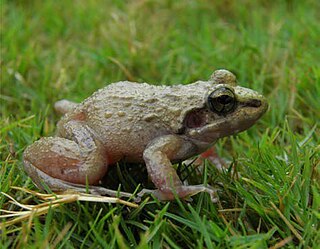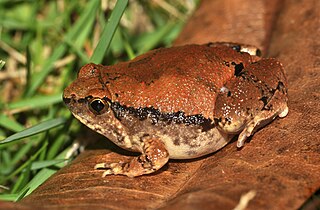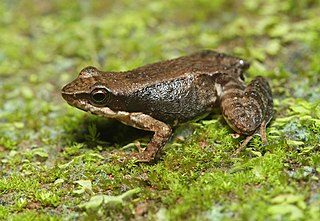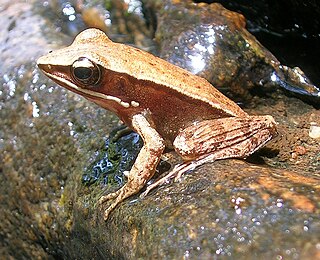
Indosylvirana temporalis, commonly known as the bronzed frog or Günther's golden-backed frog, is a species of true frog found in the riparian evergreen forests of the highlands of southwestern Sri Lanka. They are found abundantly on or close to the ground near water. Individuals are not shy and react by jumping only when provoked. They are important prey of many species of snakes, including the vine snake. Some related species found in the Western Ghats of India were formerly included in this species but were separated in a 2014 study.

Indirana beddomii, Beddome's leaping frog, Beddome's Indian frog, or simply Beddome's frog, is a species of frog found in the Western Ghats. They are usually detected by their long leaps as they flush from the ground when disturbed. The species is named after the naturalist Richard Henry Beddome.

Indirana leithii is a species of frog in the family Ranixalidae. It is endemic to the northern Western Ghats of India. As currently defined, its range is restricted to the states of Maharashtra and southern Gujarat; earlier records elsewhere refer to other species.

Microhyla rubra is a species of narrow-mouthed frog endemic to India. Earlier thought to exist also in Sri Lanka, new studies suggested that Sri Lankan population is a different species, now elevated to species level as Microhyla mihintalei.

Indosylvirana aurantiaca, commonly known as the golden frog, is a species of frog endemic to the Western Ghats of India. The species is also known as the Trivandrum frog, the common wood frog, or the small wood frog.
Uperodon nagaoi, also known as the Nagao's pug-snout frog or Nagao's globular frog, is a species of frogs in the family Microhylidae. It is endemic to Sri Lanka and is known from the Central, Sabaragamuwa, Southern, and Western Provinces. The specific name nagaoi honours Eijiro Nagao, president of Marusan Securities who, through the Nagao Environmental Foundation, has supported research on Sri Lankan amphibians.
Odorrana absita is a species of frog in the family Ranidae. It is found in southern Laos and central Vietnam. It was originally described in genus Huia. Its type locality is Xe Sap National Biodiversity Conservation Area in southern Laos.
Odorrana supranarina is a species of frog in the family Ranidae. It is endemic to Ryukyu Archipelago, Japan, and is known from the islands of Ishigaki and Iriomote, both in the Yaeyama Group. The specific name supranarina refers to the large size of this species —at the time of the species description, it was the largest member of the so-called Rana narina complex. Common name greater tip-nosed frog has been coined for it.

Raorchestes griet is a species of frog in the family Rhacophoridae. It is endemic to the Western Ghats south of the Palghat Gap in Kerala and Tamil Nadu states, India. The specific name griet honours Griet Decock, spouse of Franky Bossuyt, the scientist who described the species. Common name Griet bush frog has been coined for it.

Hylarana, commonly known as golden-backed frogs, is a genus of true frogs found in tropical Asia. It was formerly considered highly diverse, containing around 84 to 96 valid species, but taxonomic revision resulted in a major change in the contents of the genus, and today it is recognised as containing just four species.
"Hylarana" attigua is a species of frog in the family Ranidae, the "true frogs". The exact genus-level placement of this species is uncertain because it was not included in the revision of the genus Hylarana that saw what was then very broadly defined genus split into several distinct genera, with relatively few remaining in Hylaranasensu stricto. It is found in central and south Vietnam, eastern Cambodia, and southern Laos. The specific name attigua is derived from Latin attiguus meaning "neighbor". It refers to the similarity of this species to Indosylvirana milleti. Common name similar frog has been coined for this species.
Chalcorana rufipes is a species of "true frog" in the family Ranidae. It is endemic to Sumatra, Indonesia. It was split off from Chalcorana chalconota by Robert Inger and colleagues in 2009, along with a number of other species. The specific name rufipes is derived from Latin rufus meaning reddish and pes meaning foot, in reference to the reddish tinge on the underside of the pedal webbing in life.

Micrixalus kurichiyari is a species of frogs in the family Micrixalidae. It is endemic to the Western Ghats, India, and only known from its type locality, Kurichiyarmala in the Wayanad District, Kerala state. Common name Kurichiyar dancing frog has been coined for it, in reference to the type locality.

Indosylvirana sreeni, also known as Sreeni's golden-backed frog, is a species of frog in the family Ranidae found in Southern Western and Eastern Ghats in the states of Kerala and Tamil Nadu, India, at elevations of 100 to 1500 meters.
Pseudophilautus singu is a species of frog in the family Rhacophoridae, endemic to southwestern Sri Lanka. It is known from the Kanneliya-Dediyagala-Nakiyadeniya, Kitulgala, and Kottawa Forest Reserves and from the Sinharaja World Heritage Site. The specific name singu is Sinhalese for "horn" and refers to the horn-like tubercles on the upper eyelids of this frog. Common name Sri Lanka short-horned shrub frog has been coined for it.
Amolops akhaorum is a species of true frogs discovered in 2007 in the Nam Ha National Protected Area, north-western Laos. It is still only known from its type locality. The specific name akhaorum refers to the local Akha people who helped with the fieldwork of the team who discovered the species.

Lankanectes pera is a species of frog in the family Nyctibatrachidae. It is the second species found within the genus Lankanectes. It is endemic to Sri Lanka.
Microhyla mihintalei is a species of frog in the family Microhylidae. It is endemic to Sri Lanka.
Indosylvirana serendipi, or the Sri Lankan golden-backed frog, is a species of frog in the family Ranidae. It is endemic to Sri Lanka.

Indosylvirana is a genus of ranid frogs endemic to South and Southeast Asia.











